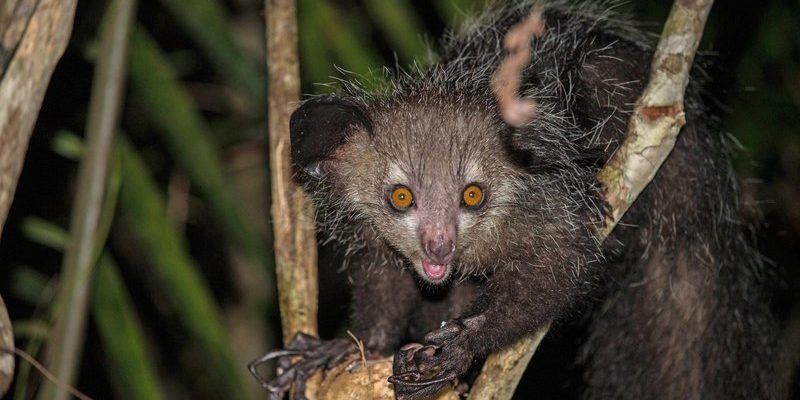![Comparing The Aye-Aye Vs. [Similar Species]](https://gudri.com/wp-content/uploads/2025/06/Comparing_The_Aye_Aye_Vs___Similar_Species__image_0.jpg)
The aye-aye, a nocturnal lemur native to Madagascar, is notorious for its unusual features, including its long, skeletal middle finger. The tarsier, on the other hand, is a tiny primate found in Southeast Asia known for its large, captivating eyes and impressive leaping ability. By comparing the aye-aye and the tarsier, we can better appreciate their roles in the ecosystem and what makes each of them so special.
Let’s explore these two remarkable creatures side by side and uncover their similarities and differences.
Physical Characteristics
When it comes to physical traits, the aye-aye and tarsier couldn’t be more different. The aye-aye has a distinct look that sets it apart in the animal world. With its shaggy fur, large ears, and that infamous long finger, it’s hard not to do a double-take when you see one. This elongated finger is not just for show; it’s essential for its foraging style. The aye-aye uses it to tap on trees to locate grubs hiding beneath the bark, much like a carpenter tapping to find a stud in the wall.
In contrast, the tarsier is small—about the size of a human fist—and has large eyes that seem almost cartoonish. These eyes are perfect for its nocturnal lifestyle, helping it see in low-light conditions. Tarsiers are also notable for their flexible necks, allowing them to turn their heads nearly 180 degrees. It’s an adaptation that aids in spotting prey or potential dangers lurking in the dark.
Both animals have unique adaptations suited to their environments, showcasing the beauty of evolution. The aye-aye’s unusual foraging technique and the tarsier’s powerful vision highlight how different habitats can shape the physical traits of species.
Habitat and Distribution
The aye-aye is exclusively found on the island of Madagascar, which is known for its rich biodiversity. It typically inhabits rainforests but can also venture into other forested areas. Aye-ayes prefer to live in trees, where they can easily access food sources and evade predators. Unfortunately, habitat loss due to deforestation poses a significant threat to their survival, making conservation efforts crucial.
On the other hand, tarsiers are spread across several Southeast Asian countries, including the Philippines, Borneo, and Sumatra. They live in the tropical rainforests of these regions, where the dense foliage provides ample cover for hunting and hiding. Tarsiers thrive in trees, using their leaping abilities to navigate through the canopy. This habitat allows them to remain hidden from larger predators, such as snakes and birds of prey.
Understanding where these creatures live helps illuminate how their environments influence their behavior and lifestyle.
Diet and Feeding Habits
Diet is another area where the aye-aye and tarsier diverge significantly. The aye-aye is an omnivore with a particular fondness for insects—especially wood-boring larvae. Using that long finger, it drills into tree bark to extract grubs, which are a crucial part of its diet. This foraging method is not just unique but also vital for the ecosystem, as it helps control pest populations in its habitat.
Tarsiers, however, have a more carnivorous approach to eating. They primarily consume insects, but they also hunt small vertebrates, including birds and even small mammals. Their large eyes and remarkable agility allow them to detect and pounce on their prey with impressive precision. Picture a tiny predator leaping from branch to branch, silently stalking its next meal—it’s a fascinating aspect of their behavior.
The differences in diet reflect their adaptations to their respective environments and available food sources, showcasing nature’s ability to shape creatures for survival.
Behavior and Social Structure
When comparing the aye-aye and tarsier, behavior is a key area to explore. Aye-ayes are generally solitary animals, spending much of their time alone in the trees. They’re nocturnal, which means they’re most active at night while others are resting. This solitary lifestyle can be attributed to their unique feeding habits; they need to forage for food without competition from others of their species.
In contrast, tarsiers often exhibit social behaviors, forming small groups that can include family members. They tend to be more communicative than the aye-aye, using vocalizations and body language to interact with one another. Interestingly, their social structure can change depending on food availability, which highlights their adaptability.
The contrasting behaviors of these two primates illustrate different survival strategies—solitary foraging versus social hunting—and how each has evolved to thrive in its environment.
Conservation Status
Both the aye-aye and the tarsier face significant threats in the wild. The aye-aye is listed as endangered due to habitat loss primarily caused by deforestation. Additionally, they’re often misunderstood and sometimes killed by local people who view them as omens of bad luck. Conservation efforts are critical to protecting their remaining habitats and educating communities about their importance to the ecosystem.
Tarsiers, while not currently endangered, are also at risk due to habitat destruction and hunting. The demand for them as pets or exotic animals can lead to populations declining. Conservation groups are working hard to preserve their habitats and reduce hunting pressures.
Awareness and education about both species can help promote conservation efforts and ensure they continue to thrive in the wild.
Final Thoughts
The aye-aye and the tarsier may share a love for the trees and a nocturnal lifestyle, but they embody two very different paths in the evolutionary journey of primates. From the aye-aye’s unique foraging methods to the tarsier’s impressive agility, each species has adapted beautifully to its environment.
Understanding these differences can deepen our appreciation for the diverse life forms on our planet. Both creatures serve as reminders of the importance of conservation and the need to protect their habitats. The next time you think about these fascinating primates, remember that every bit of knowledge helps in the fight for their survival. Let’s cherish our unique planet and work together to safeguard its wonders.

